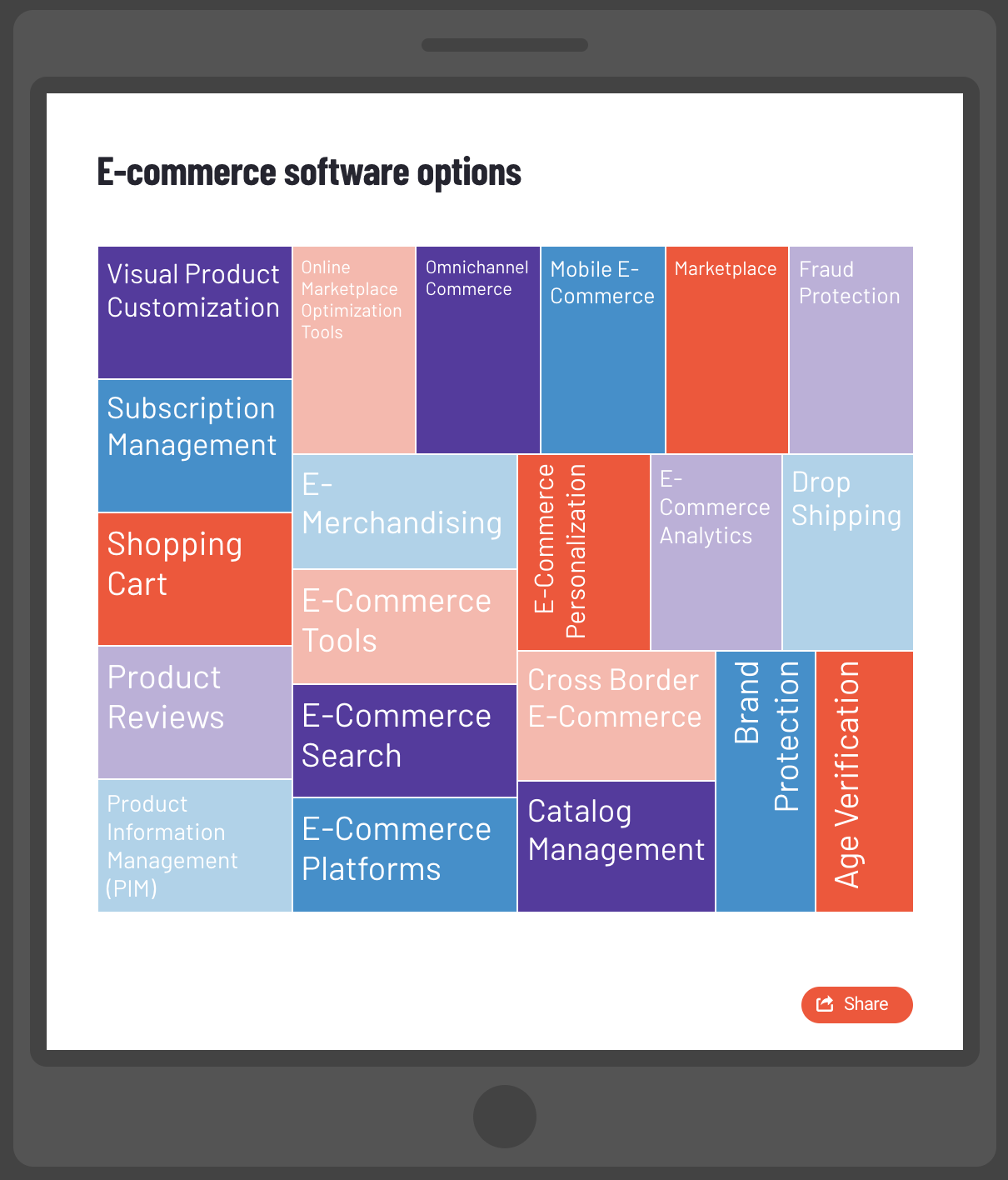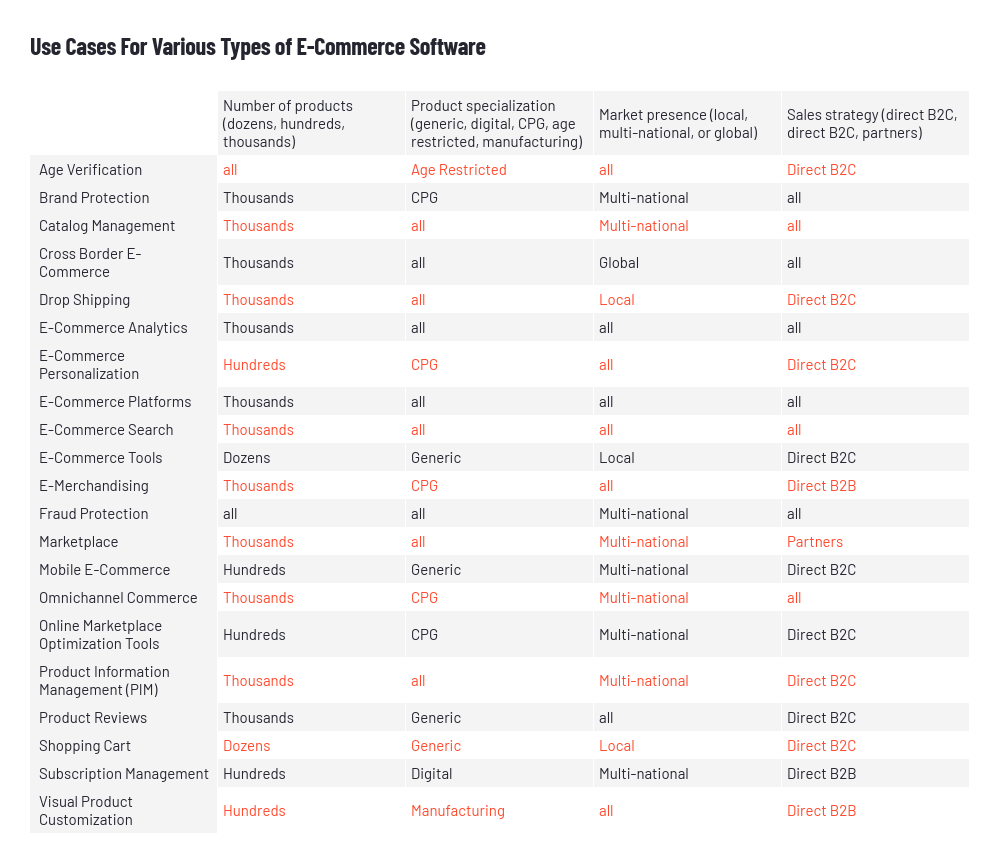If you are reading this, you have internet access and have probably already tried to buy something online. That's what e-commerce is about, at least from a buyer perspective. When it comes to sellers, things can be a lot more complicated.
The truth is that buyers and consumers don't really care what you—as the seller—have to do behind the computer screen; all they want is to be able to buy your products in a few seconds. If you can't offer them that, you'll lose customers.
The e-commerce software market is getting complicated and challenging to navigate
The good news is that many strategies and e-commerce tools can help you deliver a great experience and attract potential buyers to your store. This is also bad news—the sheer number of software options can be intimidating, and online sales strategies vary significantly depending on your market.
This guide will help you better understand the pros and cons of e-commerce software, and help you leverage its advantages and limit the potential adverse effects of its disadvantages.
Choosing a platform mix for e-commerce
| There are three major types of e-commerce platforms that you can use to sell online: |
|
The ideal would be to find the right mix between all three options, since you may find potential customers on any of them. However, it is preferable to focus on one or a few platforms after you try them all and determine which option is best for you. It’s also important to follow industry trends to understand how your market changes and adapt to them. When your customers switch from one platform to another, you want to make sure that you follow them, not the other way around.
As you can imagine, the multi-billion dollar e-commerce market is an excellent opportunity for software vendors that specialize in online sales software. The e-commerce software market was valued at $3.8 billion in 2016 and is expected to reach $4.7 billion by 2021.
As the market grows, new types of e-commerce software are launched by vendors. The most important categories of e-commerce solutions are summarized below.

| Related: What Is E-Commerce? How to Launch Your Dream Business Today → |
How to differentiate between different types of e-commerce software
There are a multitude of options because there is a demand for each kind of e-commerce software. In response to demand changes, vendors improved existing products or created new solutions for specific needs.
Shopping carts
Shopping cart software tools are the most basic type of e-commerce. This type of software allows you to create a simple online store that can be embedded on your website. While most shopping cart products integrate with solutions for payments or inventory management, these features are usually not provided out of the box.
The main benefit of shopping cart software is that it's reasonably priced, sometimes even free. Many open-source shopping cart software options can be used at no cost but require some effort to deploy and use. For instance, you may need to download the installation package, upload the files on a web server, run the installer, and then configure and use the product. There are also all kinds of tech requirements for the software to work correctly, such as Apache Server, PHP, MySQL database, and so on.
For those who don't need to worry about servers and databases, the ideal option is to choose a cloud solution. Another useful option for small companies is to use a free website builder software, which includes features to create online stores. (A few examples of website platforms that you can use to create online stores are Wordpress.com, Weebly, Wix.com, and Squarespace.) It is important to note that while creating websites on these website builder platforms is free, adding an online store isn't always included in the free version.
E-commerce platforms
This type of software usually provides all or most of the features you may need for e-commerce. That being said, there are significant differences between platforms, and they're not always easy to identify.
| Here's how to compare e-commerce platforms so you can differentiate them: |
|
Security solutions provided by the vendor should also be an early consideration when selecting a cloud provider. These tools can help improve user governance and contribute to control data in transfer better. Users should also be well aware of who has privileged access to their business-critical applications. This should be done both in terms of internal employees and the vendor's staff controlling your services.
Reviews software
According to research from CPC Strategy, an honest review is the fifth-most important reason why shoppers buy online. Reviews are more important than reward programs, recommendations by family and friends, or brand reputation.
As a result, some vendors decided to specialize in product reviews software, which helps companies collect reviews, moderate and respond to feedback, and use reviews for marketing purposes.
There are two main types of product reviews software:
- Platforms that collect reviews from many users and brands (for instance, Bazaarvoice is a network of 943 million users across 6,000 websites)
- Tools that collect reviews from your website only
There are also alternatives such as Yelp, Google, or Facebook reviews, which are usually free and can be a good option when you don't want to invest in reviews software.
Catalog management
If you're old enough to remember the Sears Catalog, you'll understand why catalog management software is so crucial for e-commerce. If not, imagine trying to review the offering of a company selling hundreds of products. A simple online store doesn't include the features users need to look at many types of products quickly, sold together or separately in different variations, or products that are seasonal or only sold in specific geographical locations.
It is also critical for e-commerce companies who sell large numbers of products to reuse product information when updating their catalogs. Most offerings do not change a lot during a short period, but there are enough changes to make the task of updating catalogs a real challenge for companies.
Product information management
When you sell hundreds or thousands of products that come in different sizes or colors, you'll have a hard time performing product data management. Inaccurate product data may lead to all kinds of errors that could confuse customers and even make you lose money. For instance, the wrong description or price for a product may make customers buy a product they don't need and pay too much for.
That's where product information software (PIM) comes into play. PIM can store and manage large volumes of data on many products and their characteristics. Some types of product data managed by PIM include names, descriptions, and sometimes translations, physical attributes such as size, color, weight, and so on, as well as pricing or e-commerce shipping instructions.
PIM can also help you manage product metadata such as product categories (e.g., women, men, kids), types (clothing, shoes, toys, etc.), collections for fashion and apparel, and any other options you may use to group products. Metadata is particularly relevant to generate reports for each type, category, or group, as well as for any combination between them.
Payment gateway
To get paid for the products you sell, you'll need to either integrate your e-commerce software with payment gateway software or use e-commerce products that include payment functionality. From a consumer perspective, there are two possibilities for payments: they can either pay on your store without leaving the website or be redirected to an external payment gateway.
As for payment methods, you'll need to make sure that your online store accepts at least all major credit cards and one or more online payment platforms such as PayPal or Stripe. While you can add a PayPal button on your store without much difficulty, when your e-commerce business grows, you'll need a more sophisticated payment system. This type of software also offers secure payment processing by encrypting sensitive data and connecting your e-commerce website with bank accounts for direct transfer.
Fraud detection
Unfortunately, the success of e-commerce has its dark side: fraud. It is therefore vital to make sure that you protect yourself and your customers from hackers and cyberattacks. You can control your online store's security or payment gateway by choosing the most secure options. However, you don't have much control over your buyers' security since they may use any device, which may or may not be protected against cyberattacks.
To give you an idea of the number of cyberattacks, new research by the ThreatMetrix Digital Identity Network estimates that in the first quarter of 2018, "210 million attacks were detected and stopped in real-time; a 62% increase over the previous year." Fraud protection software can help you protect your customers at any stage of the buying process, from account creation to payment.
E-commerce search
While e-commerce platforms include basic search functionality, many don't support advanced options such as autocomplete or personalized search. To fill this gap, new vendors and providers of enterprise search software created search tools specifically designed for e-commerce. Other than helping buyers easily find products, e-commerce search software also provides recommendations and customizable search results. This type of software also tracks search history to identify buyer profiles and provide optimized shopping experiences.
Other e-commerce software products
Many e-commerce software products do not belong in any of the categories mentioned above. Some focus on features related to e-commerce, such as dropshipping or merchandising. Others, like online marketplace optimization tools, were created to help sellers improve their presence on specific platforms, such as Amazon or eBay.
We grouped more than 400 products in the E-commerce Tools category, a catch-all list for anything that isn't a good fit for other categories. Some examples of e-commerce tools are products for e-commerce data migration, billing or accounting for B2B commerce, and all kinds of apps and extensions for WordPress, Magento, Walmart Marketplace, and so on.
| Related: COVID-19 Drives E-Commerce Growth for Brick and Mortar Retailers → |
Which e-commerce software do you really need?
All the e-commerce software types described above can be beneficial but not always and not for everyone. For instance, PIM is unnecessary when you sell a few dozen products whose characteristics and details don't change much. In some cases, such as age verification, it's obvious when you need the software. In most cases, the importance of an e-commerce tool depends on the type of business, its geographical presence, sales strategy, and the type and number of products offered.
The table below describes the most common use cases for each type of e-commerce software based on the criteria mentioned above. This does not mean that they are the only or the best use cases for e-commerce software.
 Furthermore, all these tools may be sold as standalone products or as part of a platform or suite. E-commerce platforms usually include features that cover PIM, shopping cart, catalog management, personalization, and e-commerce analytics.
Furthermore, all these tools may be sold as standalone products or as part of a platform or suite. E-commerce platforms usually include features that cover PIM, shopping cart, catalog management, personalization, and e-commerce analytics.
The challenge with e-commerce platforms is that they don't provide the same level of support for these features. For this reason, you, as a buyer, may need separate tools to supplement your existing products. Also, while it's not ideal, it may be preferable to buy a few products that cover all your needs instead of one that doesn't.
Möchten Sie mehr über Einkaufswagen-Software erfahren? Erkunden Sie Einkaufswagen Produkte.

Gabriel Gheorghiu
Gabriel’s background includes more than 15 years of experience in all aspects of business software selection and implementation. His research work has involved detailed functional analyses of software vendors from various areas such as ERP, CRM, and HCM. Gheorghiu holds a Bachelor of Arts in business administration from the Academy of Economic Studies in Bucharest (Romania), and a master's degree in territorial project management from Université Paris XII Val de Marne (France).
